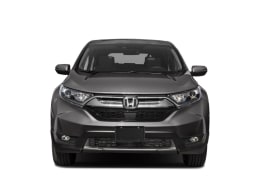Honda has redesigned its segment's best seller CR-V, and the result is better fuel economy, improved safety, sharper handling, and an upgraded interior.
The CR-V is small enough to navigate through tight parking lots, yet roomy enough inside to comfortably fit five adults. Despite a modest growth in dimensions, including two inches added to the wheelbase, the CR-V actually weighs about 75 pounds less than before and still manages to be significantly quieter and convey a substantial feel. We tested a base LX and the more mainstream EX. Both achieved impressive fuel economy of 27 and 28 mpg respectively in our testing, a new best for the class, excluding the Toyota RAV4 Hybrid. As a bonus, the turbo makes for a peppier drive.
The base LX has the 184-horsepower, 2.4-liter four-cylinder engine that's carried over from the last CR-V; it works well, sufficiently delivering power. Emulating Honda's compact Civic sedan, the CR-V now gets a small displacement turbocharged engine in most versions: The EX and above trim levels come with a 1.5-liter turbo engine that makes 190-hp, which isn't much more power, but it supplies that power earlier, reducing the need for drivers to push the engine. Most of the time, the continuously variable transmission (CVT) does its job unobtrusively but when merging or climbing, it's a struggle to mask the engine's droning whine.
Handling has improved. The CR-V corners with contained body roll and quick steering, though it's not as sporty as the Ford Escape. The ride has also improved, particularly over the 2015-2016 CR-V. Although the suspension skews firm, the ride is flexible enough and composed. Crucially, noise is much better managed. The last CR-V's notoriously loud road noise has been significantly reduced, contributing to the new car's more substantial and premium feel. Still, some competitors provide a more relaxing space.
There are more upscale touches as well. First is an attractive matte wood trim in EX and up models. More versions get comfortable front seats with a four-way lumbar adjustment -- a handy feature that even Honda's upscale Acura models lack. Also in those trims, the 7-inch touch-screen infotainment system offers Android Auto/Apple CarPlay compatibility. We are happy to see a real knob for volume control return, but it's just a halfway measure. We would also like a tuning knob or a simpler touch-screen interface; performing common tasks requires multiple, often distracting, steps. Scrolling through fuel economy and trip info proves tedious as well. The base LX's infotainment system is easier to use but, of course, it has fewer features.
Plentiful cabin storage makes it a very functional vehicle. Rear-seat room is very generous and easily accessible through doors that swing out almost 90 degrees. Visibility is good in the CR-V, except for at the rear corners. The cargo area is generous and the tailgate is easy to open. A power hatch comes on the EX-L trim. The rear seats fold flat for cargo expansion but we miss the nifty easy folding mechanism from the previous generation.
Advanced safety gear such as forward-collision warning, automatic emergency braking come with the EX and higher trims as well as adaptive cruise control, automatic high beams, lane-departure warning, and lane-keep assist. We appreciate that Honda replaced LaneWatch with an actual blind-spot detection system that covers both sides. However, we wish that all of this safety gear was also standard on the base LX model. After all, Toyota offers forward-collision warning and automatic emergency braking standard on all RAV4s, one of the CR-V's biggest competitors.
Overall, the Honda CR-V boasts notable improvements throughout that make it a very competitive, highly functional and economically sound choice in a highly competitive class. Really, its incremental size increase could make it a viable alternative for a midsized SUV. All things considered, we think it is worth the extra money to get the EX trim and all the goodies that come along with it.


























